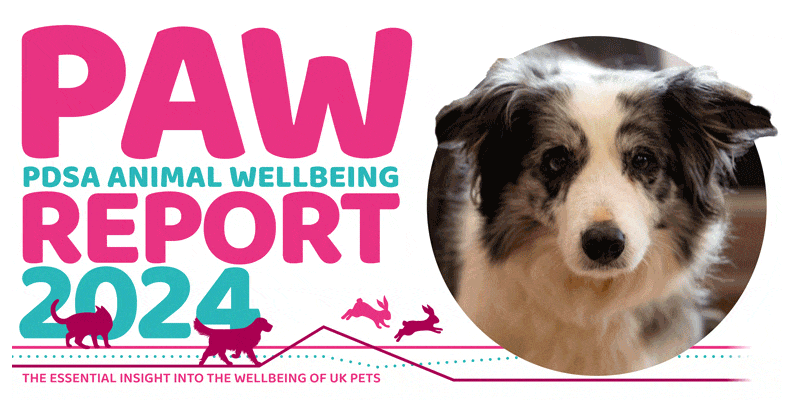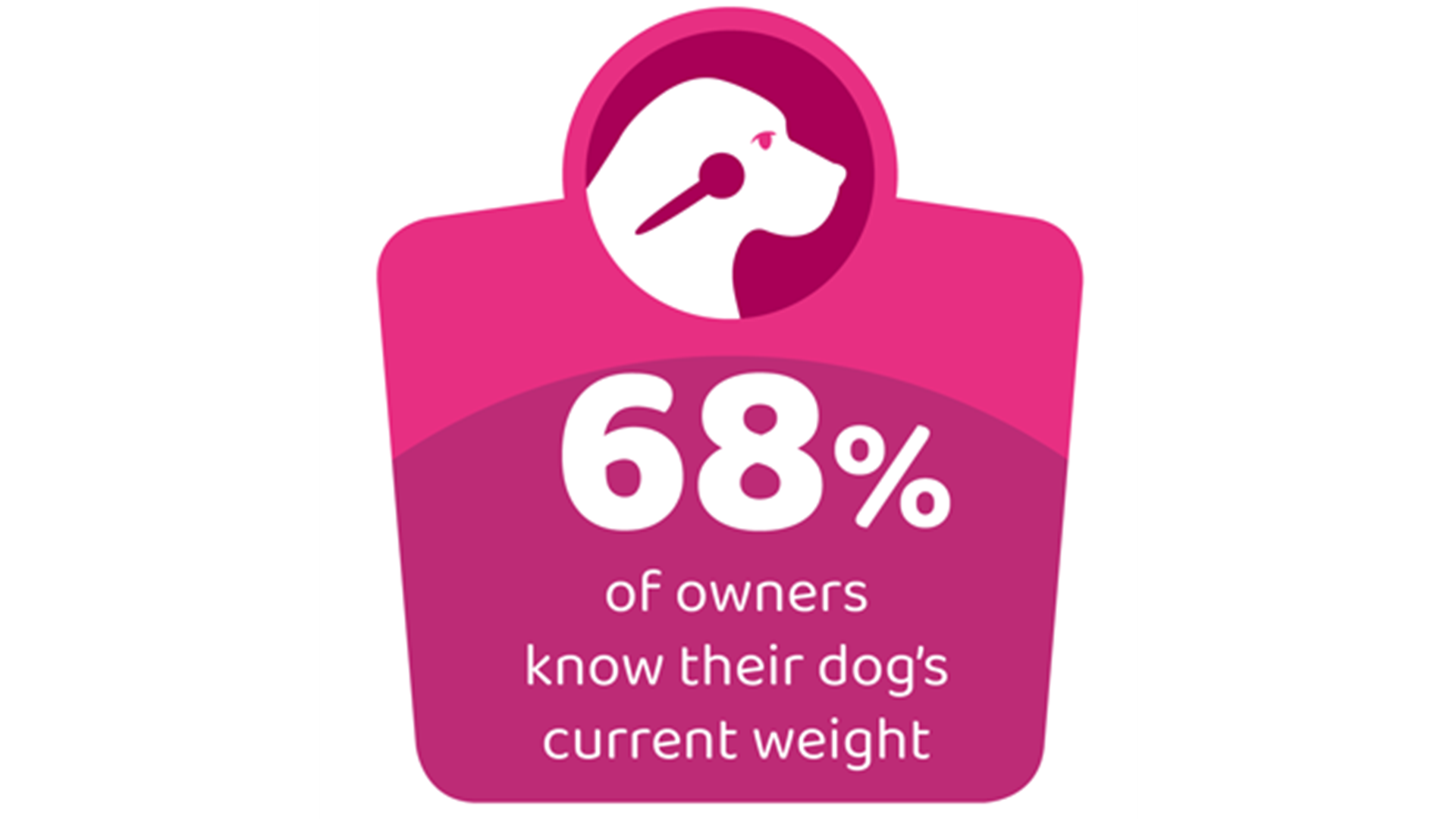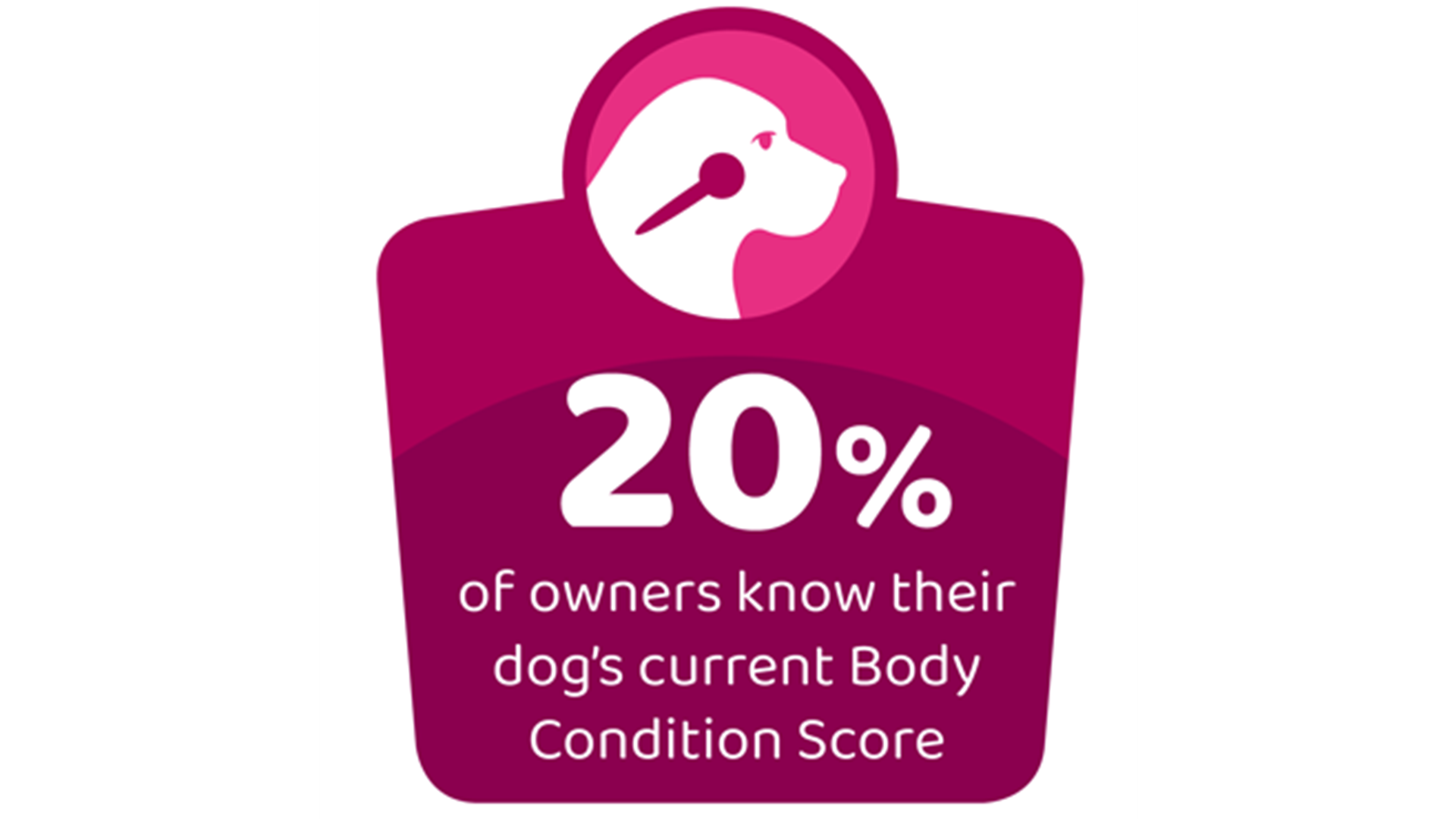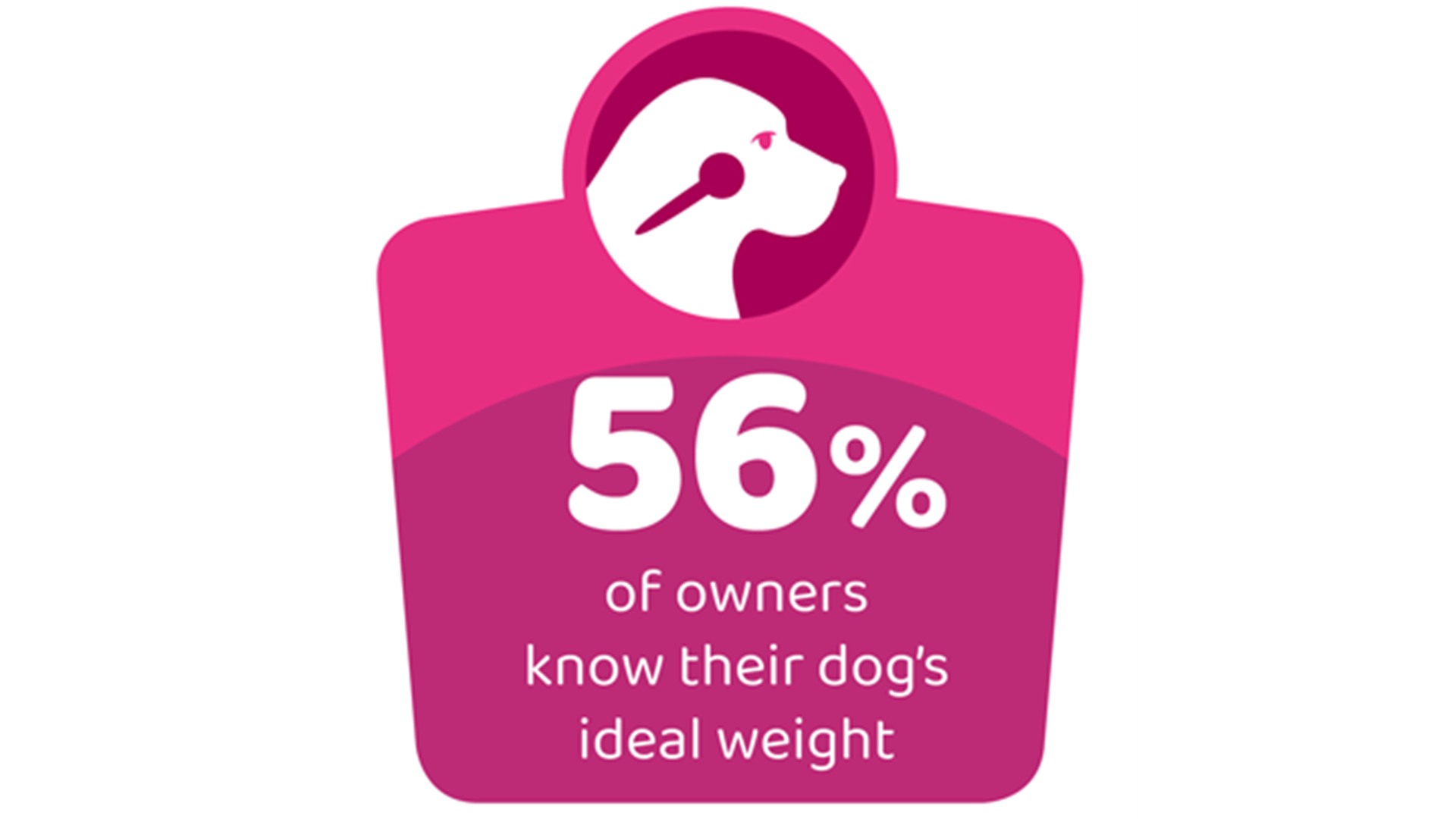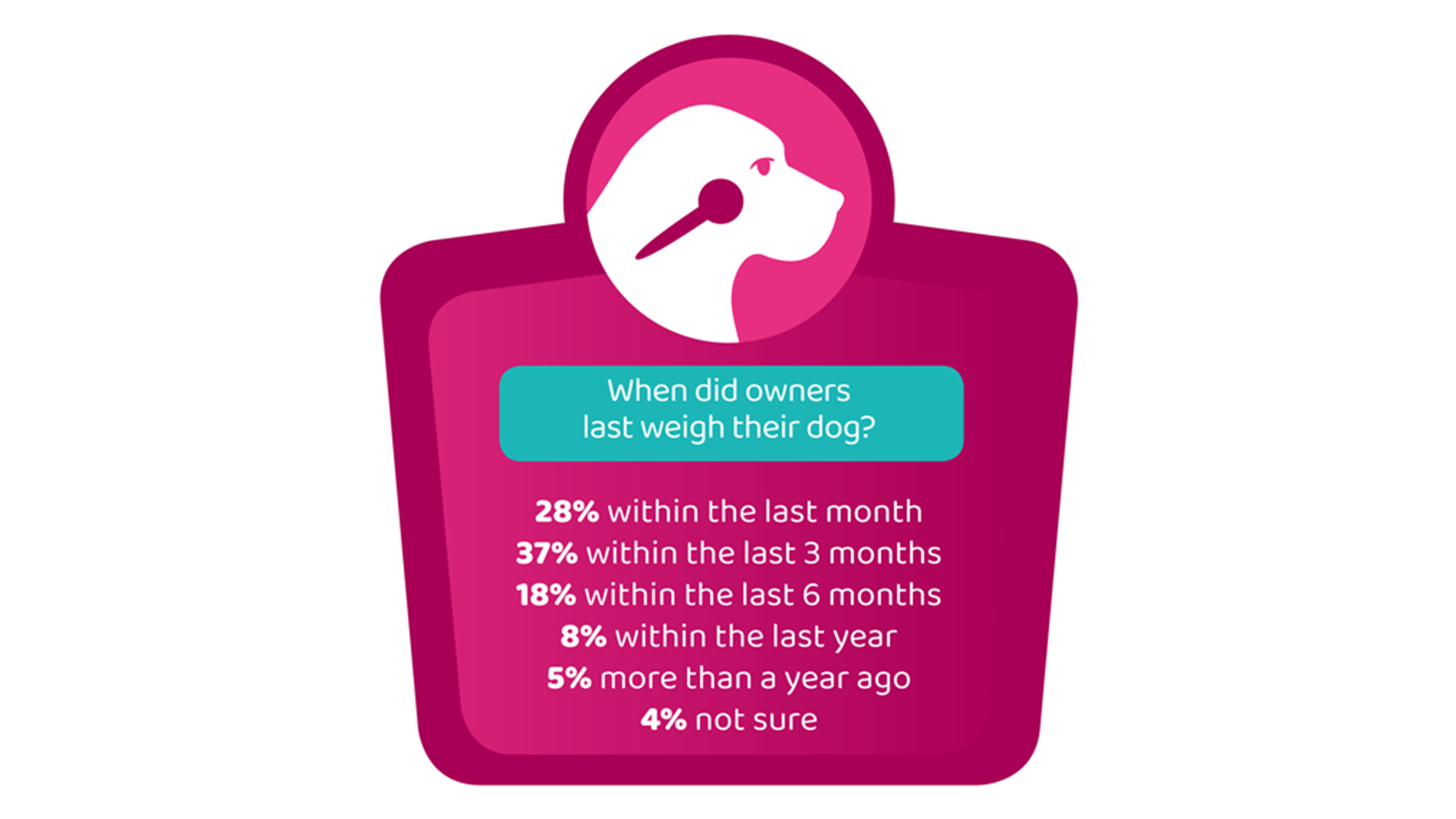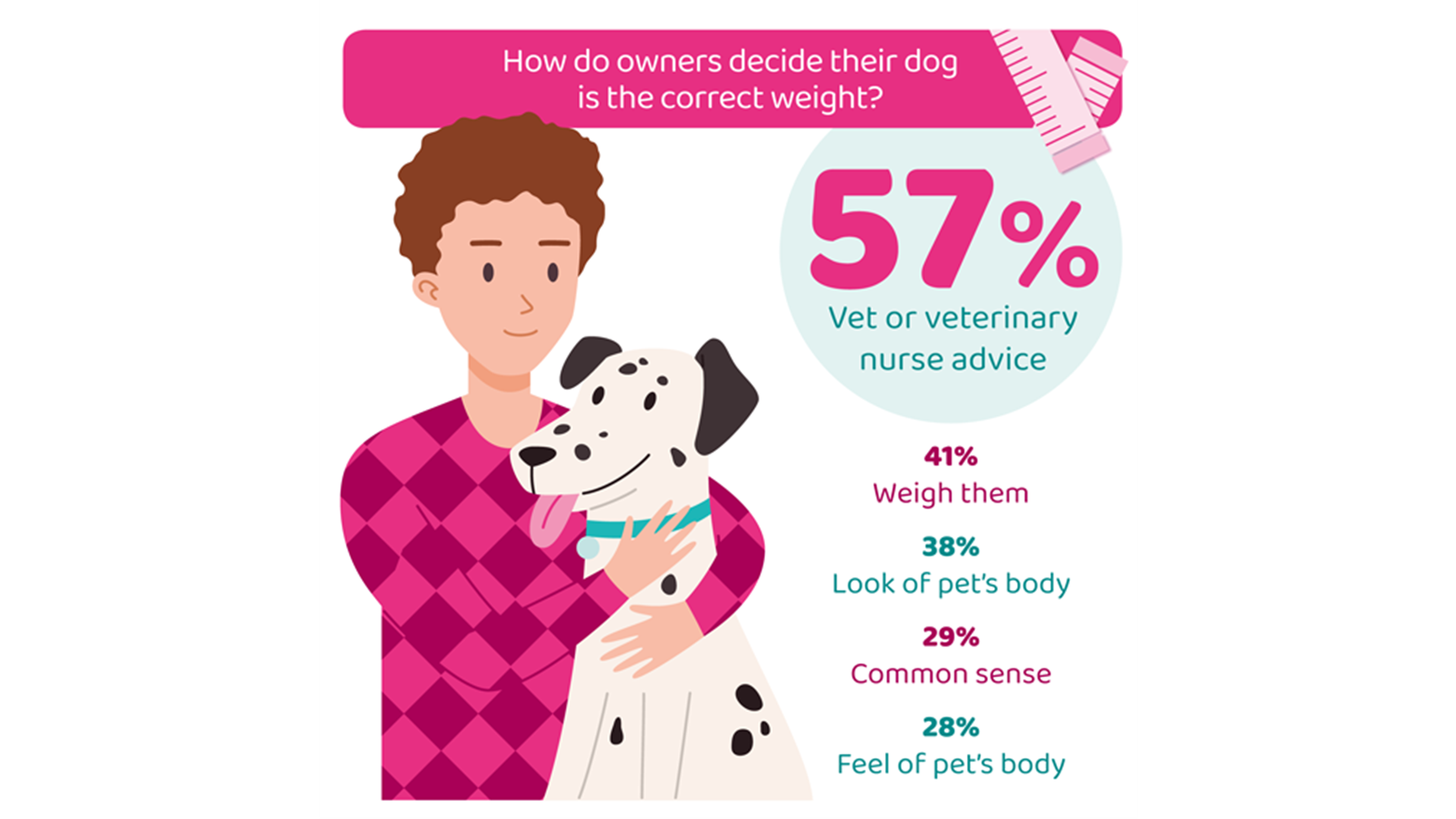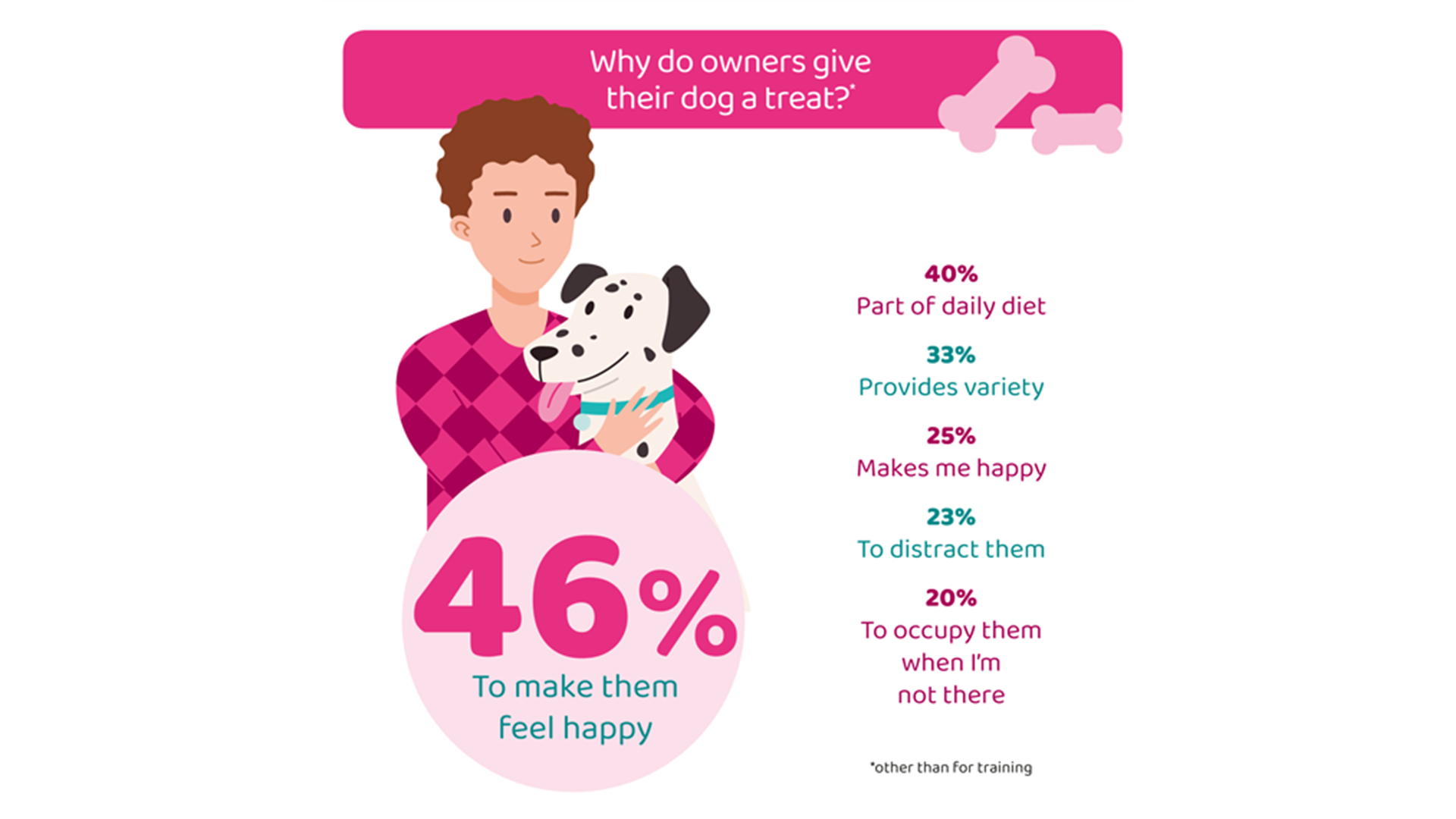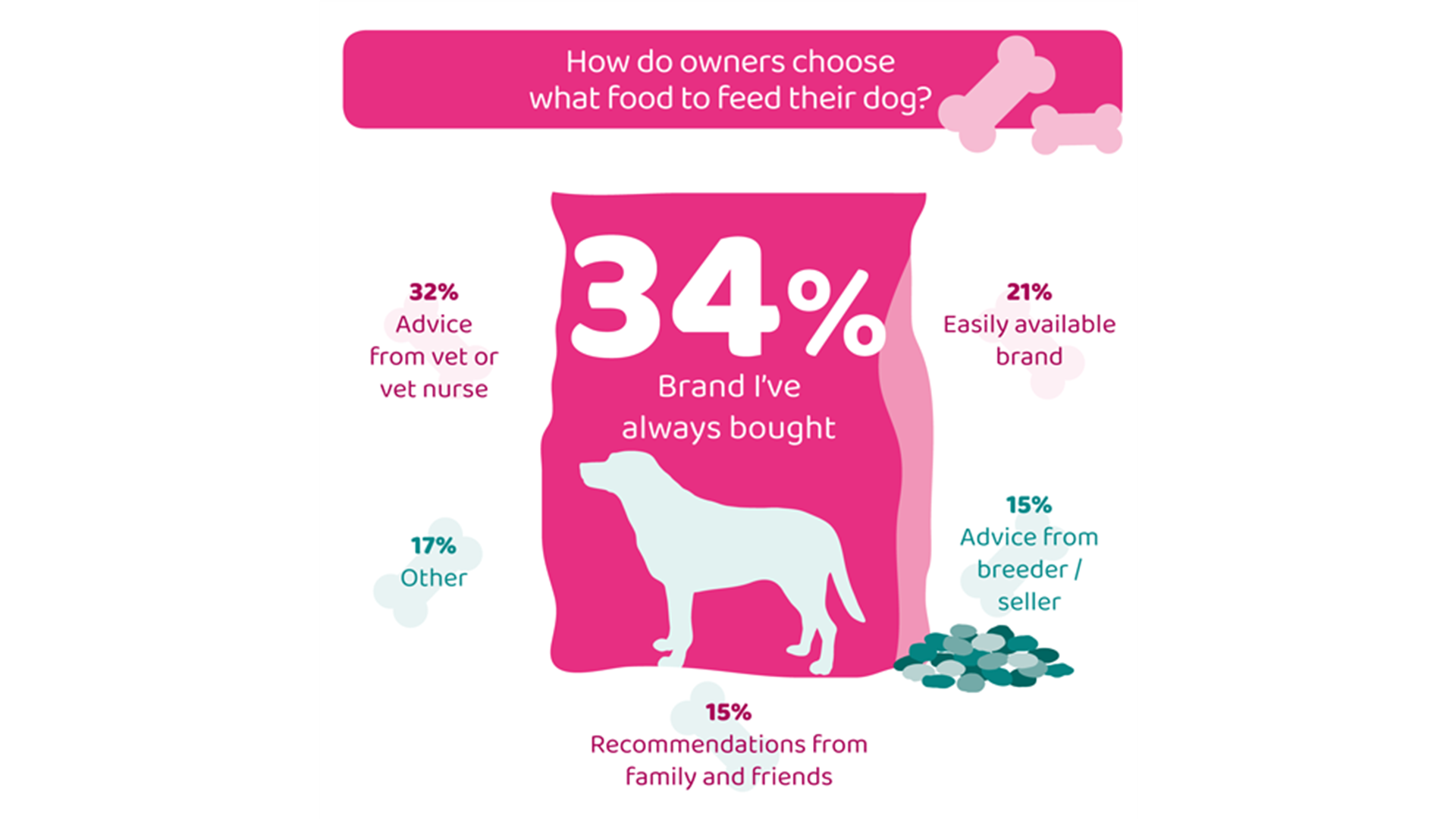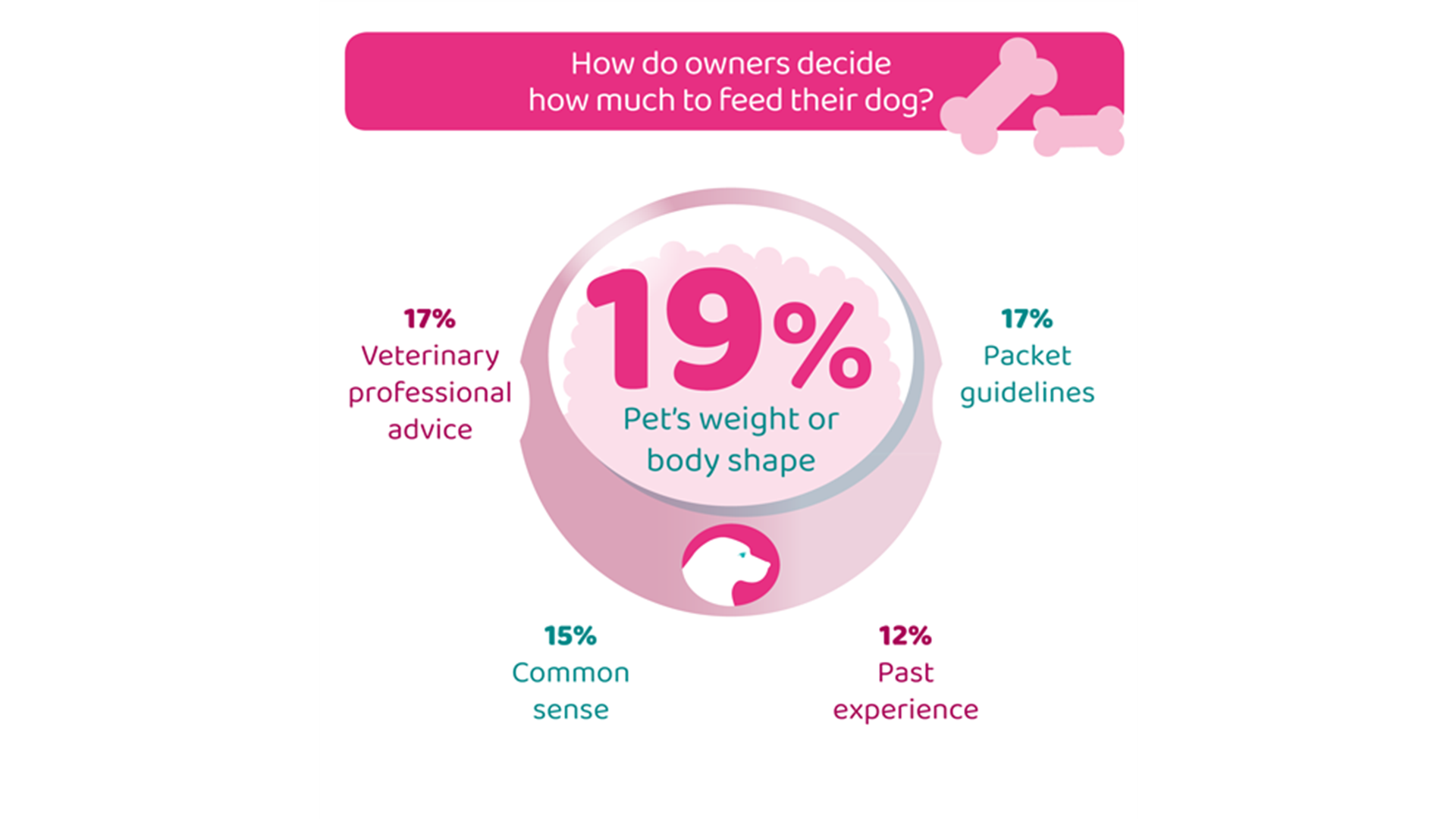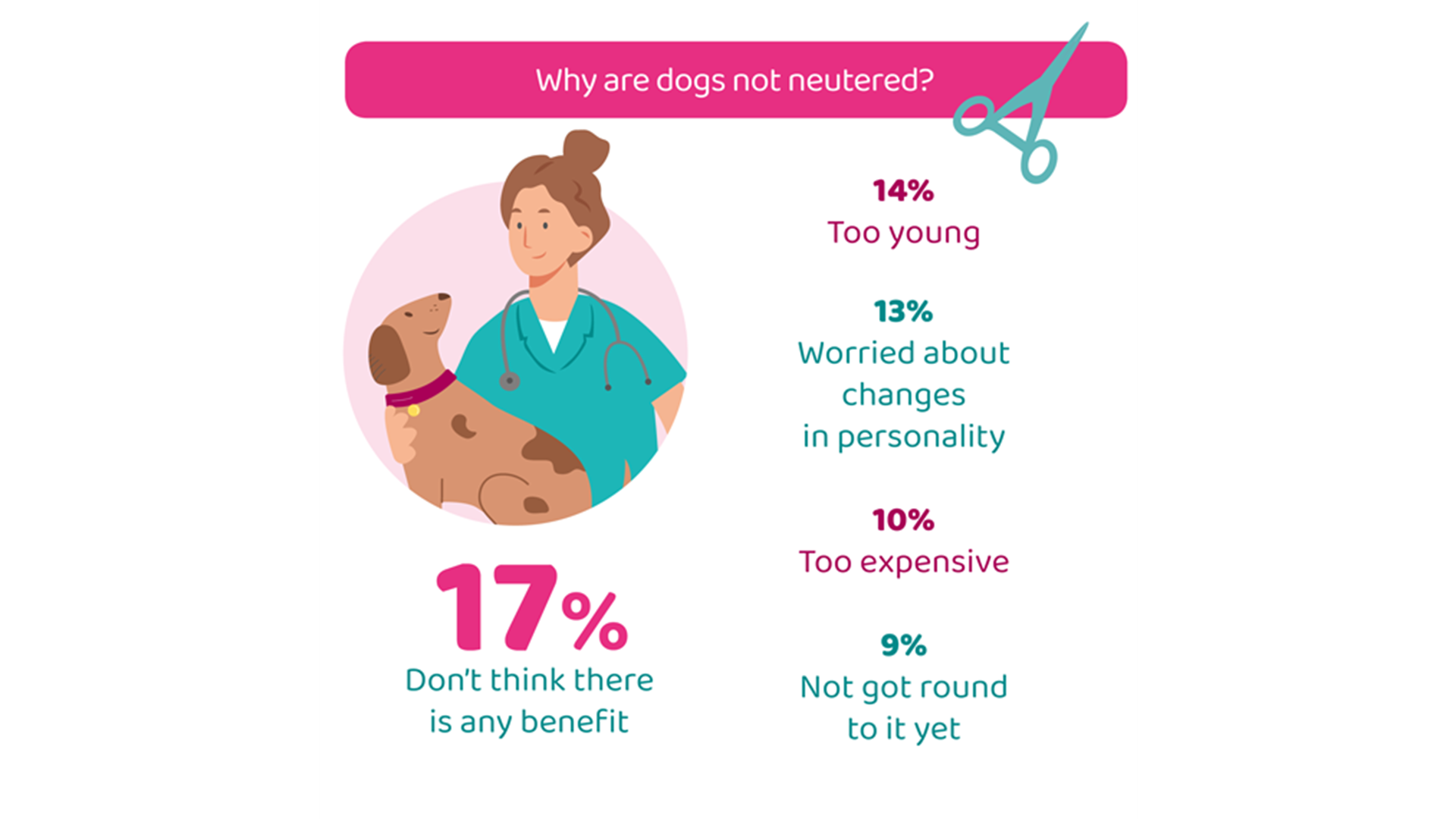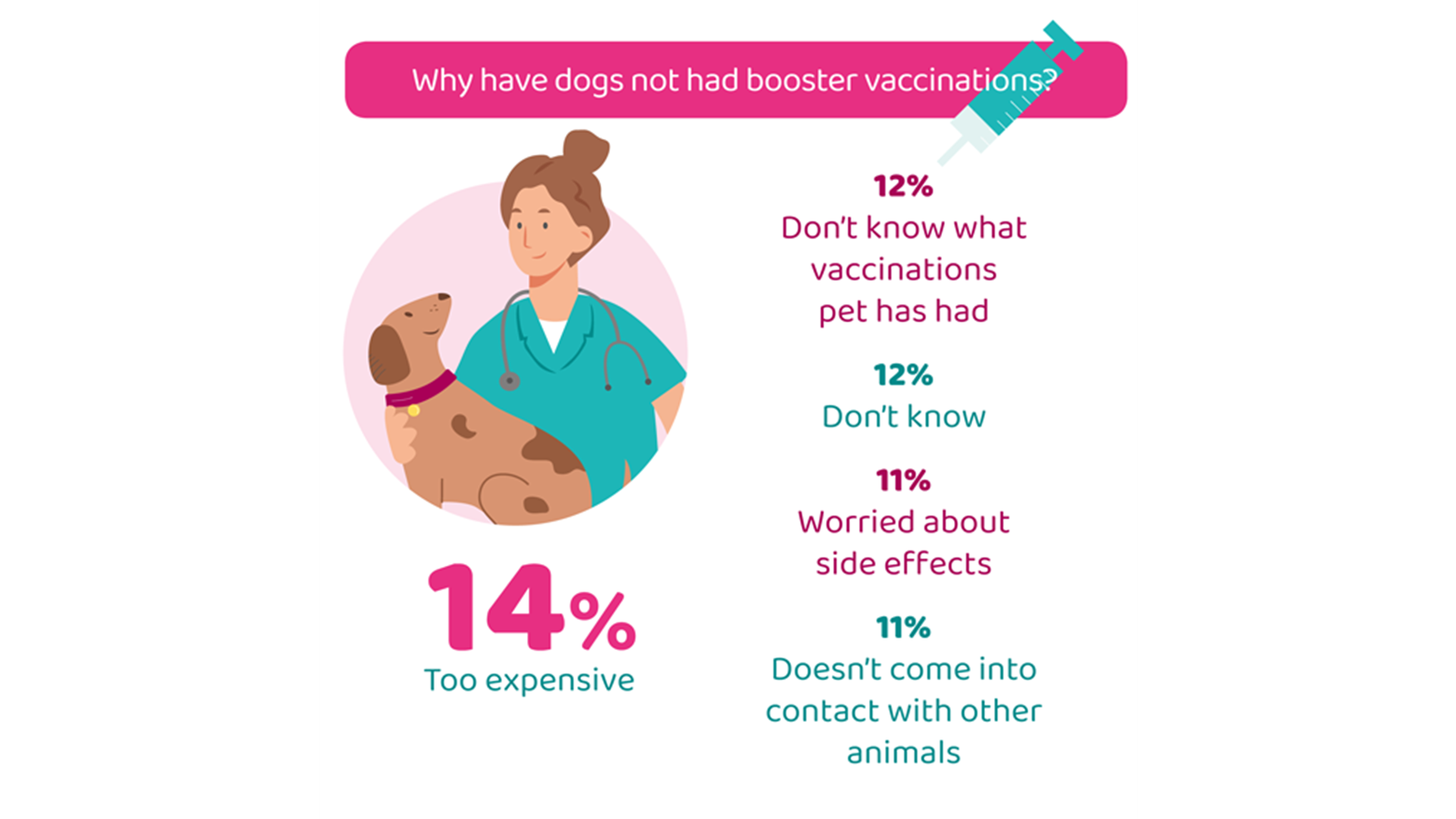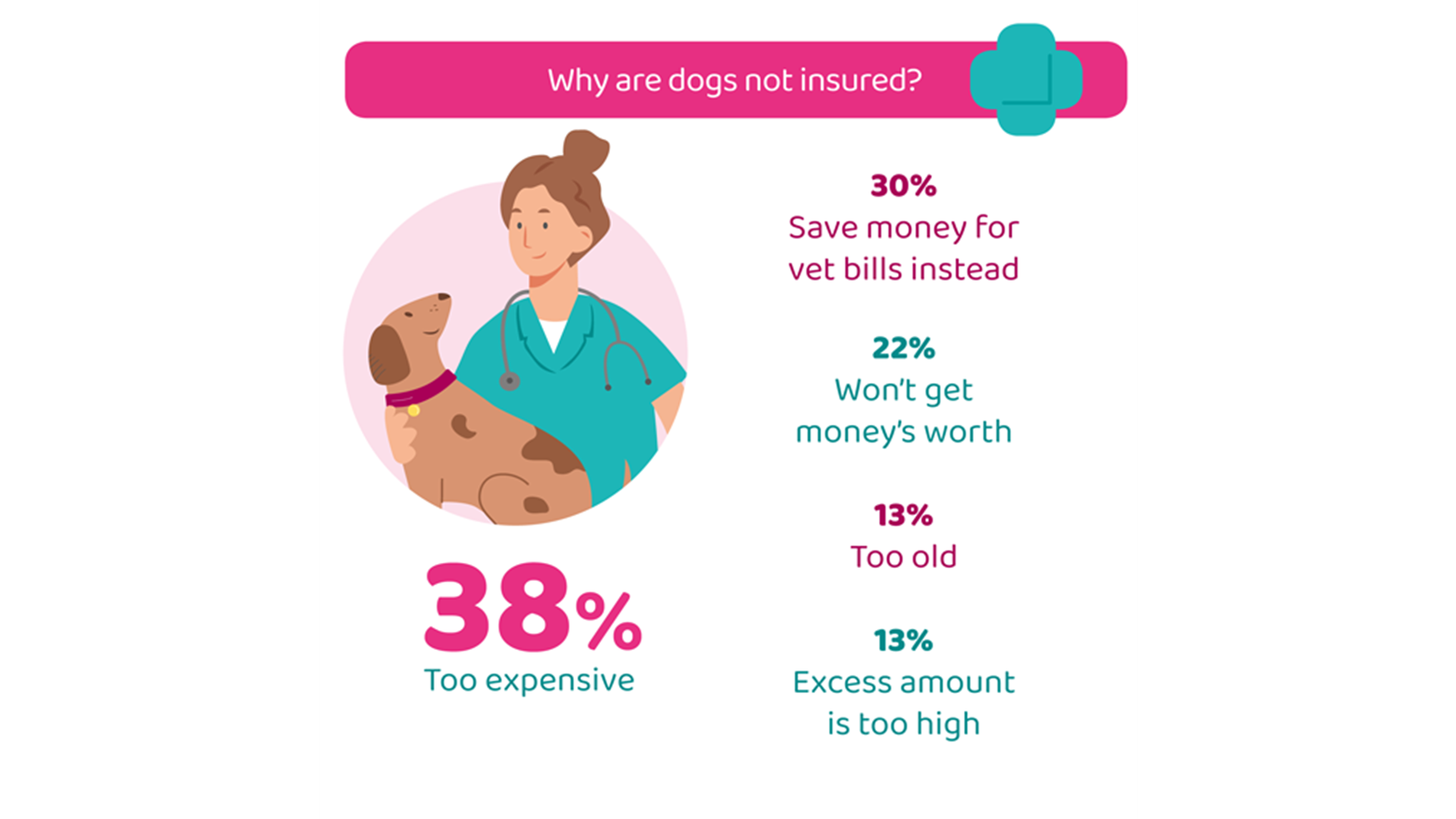Dogs
In 2023, veterinary professionals selected the following as the top welfare issues that need to be addressed for dogs:
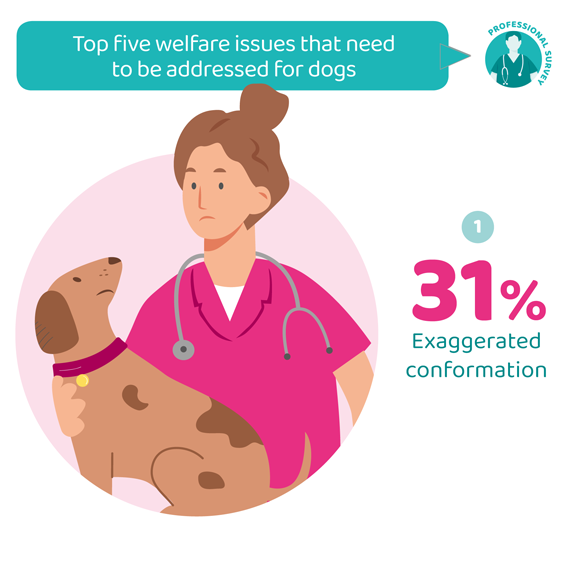
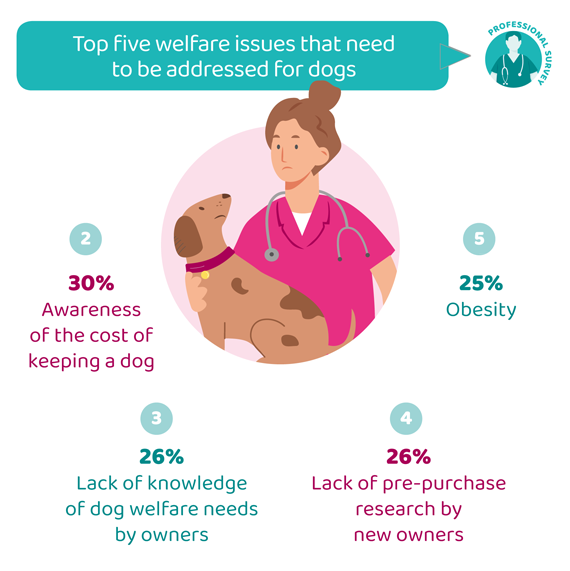
Diet and Obesity
Previous PAW Reports have consistently found that the majority of owners perceive their pet to be an ideal weight, with 81% of owners telling us this in 2022 and 79% in 2020 and 2019. In contrast, findings from our survey in 2023 show that, on average, veterinary professionals estimate that 46% of dogs are overweight or obese. Additionally, published studies have shown that up to 65% of the UK’s pet dogs are overweight or have obesity15. This discrepancy between owners’ and veterinary professionals’ perceptions is concerning and may reflect a lack of awareness amongst owners about how to recognise their pet’s ideal weight.
Despite 91% of owners reporting having weighed their dog within the last 12 months, (a significantly higher proportion than for either cat (75%) or rabbit (70%) owners), 32% of dog owners (4.8 million people) do not know their pet’s current weight, and only 56% (8.5 million people) knew what their dog’s ideal weight is. An even higher proportion of owners (80%) did not know their dog’s current body condition score (BCS). Dog owners (68%) were more likely to know their pet’s current weight than cat (47%) or rabbit (37%) owners and were also more likely (56%) to know their pet’s ideal weight than cat (36%) or rabbit (30%) owners.
5% of dog owners last weighed their pet more than 12 months ago, equating to 520,000 dogs, Of those owners, 51% (270,000 dog owners) told us they didn't feel it was necessary, 17% (86,000 dog owners) said they didn't want to pay to take their dog to the vets to get them weighed and 14% (74,000 dog owners) said it was difficult to get their dog to the vet to be weighed. For owners who are reluctant to visit their vets for weight loss advice, easily accessible, evidence-based information on how to keep their pets at the ideal weight is essential.
Veterinary teams continue to play a vital role in tackling pet obesity - 57% of dog owners look for advice from their vet or vet nurse when deciding whether their pet is the correct weight. This has not changed from last year (55%) but is lower than in February 2020 (63%). 41% weigh them (higher than cat owners at 20%), and 38% decide by the look of their pet’s body. However, only 28% said they decided whether their dog was the correct weight by feeling their body (decreased from 31% in 2022), an essential step of the BCS technique.
There is a huge amount of information on pet diets available, which is sometimes confusing and contradictory, and it can be difficult for owners to know what advice to follow. 34% of owners told us they chose their dog’s food by sticking to the brand they have always bought, and 32% took advice from their vet or vet nurse. 19% of owners decide how much to feed their dog based on their pet’s weight or body shape, and 17% follow packet guidelines. It is vital that owners are able to recognise when information is reliable and evidence-based to help them make the best choices for their dog’s nutrition.
To ensure balanced nutrition and appropriate calorie intake, treats should not make up more than 10% of the daily calorie allowance for dogs16, with a corresponding reduction in calories from their main diet. We asked dog owners why they gave their pets treats (other than for training). 46% said to make their dog happy, and 40% that they were part of their dog’s daily diet (higher than for cats, 28% or rabbits, 24%). Owners also used treats to distract their pet (23%) or to occupy them when they were not at home (20%). 28% of veterinary professionals who reported seeing a rise in pet obesity said that it was due to pets being fed too many treats.
Behaviour
Unwanted behaviours remain a serious welfare concern for UK dogs and can be a cause of stress for owners. Perceived problem behaviours can damage the bond between pets and their owner17 and are one of the top reasons for dogs to be surrendered to rescues18.
60% of veterinary professionals say they have seen an increase in dog behavioural issues in the last two years, 57% say they have seen an increase in dogs showing signs of fear in practice, and 48% say they have seen an increase in dog euthanasia due to behavioural issues in this timeframe. Of those veterinary professionals who said they’d seen an increase in dog behavioural issues over the last two years, 75% felt this was due to lack of socialisation, 66% due to owners not being able to understand canine behaviour and communication, and 64% due to lack of puppy training.
Changes in lifestyle over the last three years due to the pandemic have led to animal welfare organisations and veterinary professionals identifying two main areas of concern for emerging behavioural problems in our dogs: separation related issues and lack of socialisation opportunities19.
The 2022 PAW Report found that dogs were being left alone for longer periods of time as people returned to their workplaces and reduced the amount of home-based work hours after the COVID-19 pandemic restrictions were no longer in place. If owners have not properly prepared their dogs for this change, there is a risk of them developing separation related behaviours. In 2023, 13% of owners (1.4 million dogs) reported that their dog was showing signs of distress when left alone*; this is no different from 2022. A higher proportion of dogs acquired since 2020 are showing this behaviour (14%) compared to dogs acquired more than three years ago (11%).
It is important that dogs are exposed to a variety of positive experiences at a young age to help them to become happy, friendly and confident adults20. Opportunities for these socialisation experiences may have been lacking for some dogs over the last three years. 25% of owners said their dog was growling, snapping, biting, or showing signs of fear, behaviours that could be related to a lack of socialisation as a puppy. This has increased from 23% of dogs in 2022. Dogs acquired from rescues rehoming dogs from abroad were significantly more likely to be showing signs of fear (31%) compared to 16% of dogs rescued from the UK.
Hospital admissions in England as a result of being bitten or struck by a dog have increased over the last ten years21, with an unusually high number of fatal incidents in 202222. Several incidents have involved children, each one a tragedy, although the overall number remains low. We asked owners whether their dog had ever been bitten or had bitten or chased other animals or people. 83% of owners told us that their dog had never been involved in any of these situations. Owners of dogs who had been owned for up to three years were more likely to say that none of the options applied to them (88%) compared to owners of dogs owned for over three years (81%).
However, 6% (700,000 dogs) of dogs have been bitten by another dog outside the home, where veterinary care was needed, 3% (370,000 dogs) have bitten an unfamiliar dog and 2% (190,000 dogs) have bitten a familiar dog. Also, 3% (290,000 dogs) have bitten an owner, carer or stranger where professional medical care was needed. These proportions are not significantly different to the findings of the 2022 PAW Report.
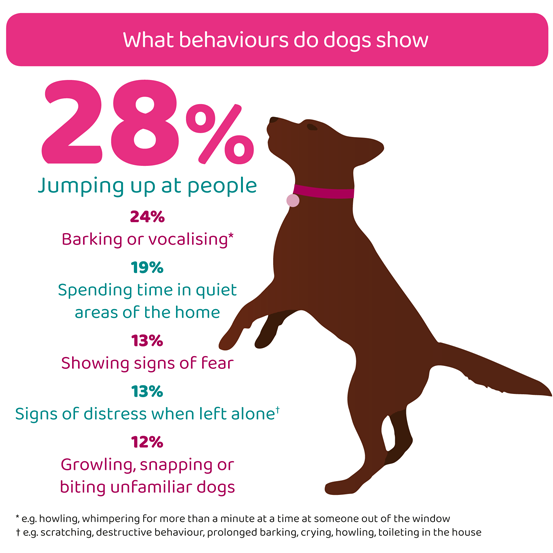
It is important to note that we do not know in what context these bites occurred, and there are multiple potential factors, both human and dog related, involved in the increase in dog bite incidents. However, incidents may be reduced by people understanding how to behave around dogs and recognising when a situation may be making a dog uncomfortable.
We asked all pet owners how they know how to stay safe around dogs. The majority of all owners (84%) told us that they knew something about how to stay safe around dogs, with a large proportion citing personal experience (63%) and 20% saying they have learnt how to behave around dogs from a friend or family member. Unsurprisingly, more cat (12%) and rabbit (11%) owners stated they do not know how to remain safe around dogs than dog owners (3%), and more cat (8%) and rabbit owners (8%) said they avoid dogs because they are scared of them than dog owners (2%).
Education is an important part of reducing the incidence of dog bites, especially among children and parents23. 14% of all owners said they learnt about how to stay safe around dogs through books and / or websites, and 8% through a training / educational course or online webinar. Dog training and socialisation, human behaviour change interventions and environmental modification (such as installing baby gates etc.) are also key to reducing dog bite incidents23.
“Data from both veterinary professionals and owners suggest that behavioural issues such as fear or growling and snapping are increasing. This is in line with what we see in hospital admissions for dog bites which are increasing yearly.
The data suggest that rises are being driven by changes in dog and ownership demographics rather than dogs becoming more aggressive. In particular, importing dogs from abroad, who may be more fearful, is becoming more common.
Key to dog bite prevention is education on safe interactions with dogs; the appropriate breeding and sourcing of a dog with a friendly temperament; and appropriate socialisation and training during the critical early months of a puppy’s life."
Prof Carri Westgarth BSc MPH PhD PGCert FHEA ABTC-CAB, Chair in Human-Animal Interaction, University of Liverpool
Preventive Health
The rising cost of living has meant many owners are looking for ways to reduce their spending and may look at preventive healthcare as one expense to be cut. In 2023, we found that 68% of dogs are neutered, a decrease from 74% in 2019, but the overall trend is relatively stable. Of those pets who are not neutered, 17% of owners told us they didn’t think there was any benefit to their pet being neutered, which was more likely to be said by owners of male dogs (24%) than females (7%). 13% were worried about changes in their pet's personality and 10% of owners told us it was because it was too expensive.
As in 2022, there remain serious concerns about capacity in veterinary practices with continued reports of staff shortages24. Of the 9% of owners who told us their dog is not currently registered with a vet, 10% (approximately 93,000 dogs) said it was because practices in their area are not taking on new clients (an increase from 6% in 2022). Additionally, some owners reported that their practice wasn’t currently providing neutering, vaccination, or microchipping procedures (3% of owners who haven’t had their dog neutered, 2% of owners whose dog hasn’t had regular boosters, and 4% of owners who hadn’t had their dog microchipped).
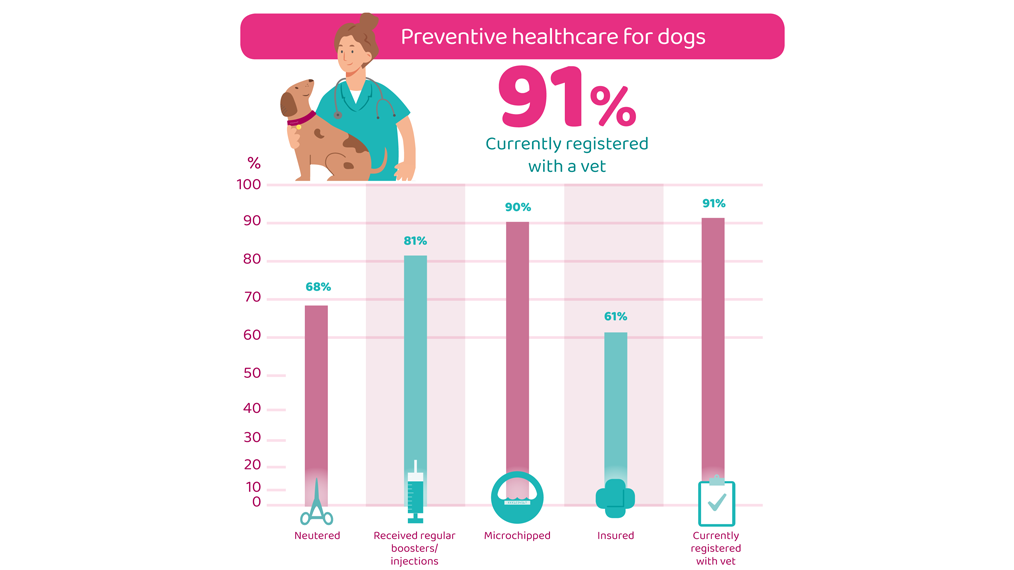
81% of dogs have received regular booster vaccinations, no different from 2022, but an increase from 77% in 2021 - such fluctuations have occurred repeatedly over the past 13 years. Of those owners whose dogs have not received regular booster vaccinations, 14% of owners said it was because it was too expensive. 11% were worried about side effects, which has increased from 7% in 2022. 51% of veterinary professionals say they’ve seen an increase in cases of parvovirus, and 35% have seen an increase in cases of leptospirosis in the last two years; both are diseases which can be prevented by regular vaccinations.
90% of dogs are microchipped – this proportion has remained unchanged for several years following the introduction of legislation making it compulsory in 201625. 11% of owners whose dog was not microchipped told us it was because they were worried about side effects, and 11% said they had never heard of microchipping. Similar to our findings in 2022, 17% of dogs acquired from abroad are not microchipped.
61% of dogs are insured. This proportion has remained the same since last year, although in 2023, 3% of dog owners told us that they were cancelling their pet insurance due to the rising cost of living. While it can seem a reasonable monthly expense to drop, cancelling insurance could leave owners struggling to afford to pay if their pet were to suffer unexpected injury or illness. 38% of dog owners who didn’t have insurance told us it was because pet insurance was too expensive, and 30% said they were saving money for vet bills instead.
Key findings about dogs from our 2023 PAW Report
 Video found at youtu.be/x7mWX62QbL0
Video found at youtu.be/x7mWX62QbL0

Footnotes
* e.g. scratching, destructive behaviour, prolonged barking, crying, howling, toileting in the house
15 German, A. J., Woods, G. R., Holden, S. L., Brennan, L., and Burke, C. (2018). Dangerous trends in pet obesity. Veterinary Record, 182, 25
16 Linder, D. E., & Parker, V. J. (2016). Dietary aspects of weight management in cats and dogs. Veterinary Clinics: Small Animal Practice, 46(5), 869-882
17 Hoffman CL, Chen P, Serpell JA, Jacobson KC. Do dog behavioral characteristics predict the quality of the relationship between dogs and their owners? Hum Anim Interact Bull. 2013;1:20–37
18 Powdrill-Wells, N., Taylor, S., & Melfi, V. (2021). Reducing dog Relinquishment to rescue centres due to behaviour problems: identifying cases to target with an advice intervention at the point of Relinquishment Request. Animals, 11(10), 2766
19 https://bsas.org.uk/blog/article/has-covid-19-caused-behavioural-changes-in-domestic-dogs
20 Puurunen, J., Hakanen, E., Salonen, M. K., Mikkola, S., Sulkama, S., Araujo, C., & Lohi, H. (2020). Inadequate socialisation, inactivity, and urban living environment are associated with social fearfulness in pet dogs. Scientific reports, 10(1), 1-10
21 NHS Digital (2012) Hospital Episode Statistics, Admitted Patient Care - England, 2011-12. Hospital Episode Statistics, Admitted Patient Care - England, 2011-12 - NHS Digital NHS (digital (2022) Hospital Admitted Patient Care Activity, 2021-22. Hospital Admitted Patient Care Activity, 2021-22 - NDRS (digital.nhs.uk)
22 https://deframedia.blog.gov.uk/2022/10/06/defra-response-to-reported-recent-increase-in-fatal-dog-attacks/
23 Jakeman, M., Oxley, J. A., Owczarczak-Garstecka, S. C., & Westgarth, C. (2020). Pet dog bites in children: management and prevention. BMJ paediatrics open, 4(1)
24 https://www.vettimes.co.uk/news/staff-shortages-leave-vet-sector-facing-ticking-time-bomb/
25 Microchipping of dogs legislation (2015) https://www.legislation.gov.uk/ukdsi/2015/9780111125243

